Hong Kong style sausage rolls (also called hot dog rolls, hot dog buns) is a hybrid of hot dog bun and the western sausage rolls wrapped in puff pastry. It is the inevitable outcome of the western cultural assimilation into the local culinary, which emerged as a new variant as a soft bun with sausage wrapped within.
These sausage rolls are immensely popular as breakfast for school kids and snacks during afternoon tea. It was also my favorite when I was a kid when living in Hong Kong. Now I live in Malaysia and still love this sausage bun, which is sold in nearly every bakery.
In this recipe, I will use the same recipe for my Japanese milk bread to make the dough for the sausage rolls. The only difference is replacing the milk powder with milk. (Please refer to my Japanese Milk Bun recipe for more explanation. I have a lengthy discussion on how to make the soft bun.)
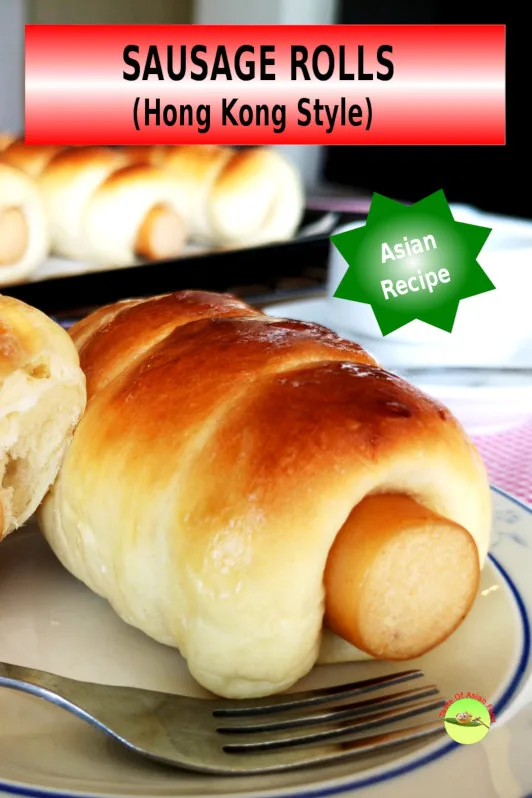
Note: This post may contain affiliate links. Please read my privacy policy for more info. I may receive commissions for purchases made through links in this post. As an Amazon Associate, I earn from qualifying purchases.
1. Prepare the TangZhong (the water roux)
TangZhong (water roux) is the secret weapon to make this bread soft and fluffy. Here are the steps.
- Combine the bread flour and water in a small pan until there are no more lumps.
- Place the pan on a stove over low heat and keep stirring until the mixture starts to thicken to form a water roux. That is when the temperature is about 65°C.
- Remove from heat. The mixture will become translucent, which you can draw lines on the roux with your chopstick or spoon.
- Let the roux cool down before adding it to the bread dough.
The gelatin from in the roux will absorb more water and, therefore, be able to form a bread dough with higher moisture content, resulting in a fluffy and moist texture.
2. Combine all the ingredients
Combine the bread flour, the water roux that we have made, sugar, salt, egg, water, and yeast. Here is a brief explanation for each ingredient.
Bread flour
High protein flour is required to make good quality bread or buns. Bread flour contains 12 to 14% of protein. The high content of protein is essential to form gluten during the bread-making process. When the floor is wet by water, the protein will react and denature and develop into long and curly strings called gluten. Gluten is what makes the bread to become elastic and springy.
Yeast
I am using active dried yeast, but you can use any yeast you like. I like to add two tablespoons of water to the yeast to bloom for five minutes before adding it to the flour. It is not necessary to add sugar to nourish the yeast first, as the yeast will eventually mix with the sugar. I like to mix it with milk to dissolve before pouring it into the mixer fully.
Sugar and salt
Sugar and salt help to improve the flavor of the bread. Besides this, sugar is a nutrient to yeast. The yeast will convert the sugar to alcohol to produce the unmistakable aroma of the bread.
Egg
Egg provides additional flavor. You need to increase the water content if you do not use egg in the recipe.
The water content for the sausage roll dough
I usually make bread with the water content of about 60 to 63 percent. That means the dough needs 63 ml of water for every 100 g of flour. It forms a very soft dough with this percentage of water, which is quite challenging to form into any shape.
The percentage of water in this recipe is 66%. Bread dough with such a high percentage of water content usually is more suitable to make loaves, which will take the shape of the bread tin. It is also very sticky and requires plenty of flour dusted on the work surface. One such example is ciabatta.
In this recipe, the dough is not sticky and is easily formed into any shape that you want even with relatively high water content, thanks to the presence of TangZhong (the water roux).
How to calculate the water percentage in this sausage rolls recipe
- The total amount of flour is 15 grams from the TangZhong plus 250g from the main dough. Therefore, the total is 265g.
- The total amount of water is 65 ml from the TangZhong, 75 ml from the milk, and 37 ml* from the egg. Therefore, the total is 177 ml.
- Therefore, the percentage is 177 / 265, which is equal to 66%.
* One egg (excluding the weight of the shell) is 50g. Since eggs contain 75% of water, the water content of one egg is 50g x 0.75 = 37g (about 37ml).
3. Use an electric mixer or bread machine to make buns
I have tried to knead the dough by hand, but an electric mixer always yields a better result. Although in theory, you can knead the dough until the gluten is thoroughly developed, it does not happen in practice (to me at least). There are two reasons :
- I tend to get lazy (tired) and allow myself to stop mixing even though it has not fully done yet. It is just human nature.
- It is hassle-free with the electric mixer. As a comparison, it is hand-free, starting from mixing to the fermentation process. There is no additional flour to dust your hand or the work surface because everything is completed with the electric mixer. After the dough has doubled in size, it is no longer sticky anymore since gluten has developed, and hence hardly sticks to your hand.
Similarly, you can use your bread machine if you have one. I do not make bread daily, so just use my hand-held mixer to get things done.
Use the dough hook attachment to make bread
After mixing the ingredients for a few minutes, they will start to clump together to form a dough. Continue mixing the dough until it becomes an elastic ball. You can test it by lifting the dough hook, and the dough should stretch out like a rubber band. This appearance shows that gluten has formed in the dough.
If you find that the dough is too dry, you can consider adding some extra water at this stage. I suggest adding water one tablespoon at a time and mixing it until it is fully absorbed. Stop adding when the dough starts to become sticky while touching by hand. Conversely, you can add some flour if it is too sticky. Once the water is entirely absorbed into the dough, add the butter.
Add the butter last
The butter (or other oil, if you want to use) should be added after the above ingredients have turned into an elastic dough. Butter will slow down the formation of gluten, and therefore it should be added after the gluten is well developed.
Continue mixing until all the butter is thoroughly blended into the dough. The dough should no longer look oily.
4. Bulk fermentation
By now, the dough should look like an elastic ball that stays clean from the mixing bowl. Cover the dough with a damp cloth and let the dough double in size.
The dough will double its size in 30 to 40 minutes if you leave it at room temperature between 25°C to 30°C. You can also keep it in the refrigerator to let it ferment slowly, which will result in a better texture and aroma. The fermentation will take longer at a lower temperature, and therefore should be prepared a day earlier. I usually make it a night before and continue the next day when the volume has doubled up. You can test it by poking two fingers into the top of the dough. The fermentation is completed if it forms two dents by your fingers without bouncing back.
5. Punching, portion, rounding, resting and folding the dough
Punching
Use your fist to punch down the dough to squeeze out the gas. Punching helps to release as much gas as possible so that it is easier to manage.
Now sprinkle some flour on the work surface and pour the dough which has been punched down. It should flop out in one giant blob onto the table.
Do a stretch test to check the development of gluten
Before dividing the dough into small portions, do a quality control test to check if the gluten is fully developed. The dough should be able to withstand a stretch until it becomes paper-thin and translucent. If the dough breaks while trying to stretch thinly, knead the dough by hand on the work surface for one to two minutes and check again by performing another stretch test. Kneading helps to develop gluten.
Divide the dough into the small portions for wrapping the hot dog
Once the dough passes the stretch test, divide the dough into small portions of equal size, which corresponds to the number of sausages you have. The amount depends on how big you want the sausage rolls to be. I am using sausages with a diameter about 1.5cm (3/4 inch) with 10cm (4 inches) length, which will yield eight medium size sausage rolls. You can also divide the dough into ten portions (with ten sausages) if you prefer sausage buns with less dough. The average weight of the dough per bun is about 53 g x 10 portions or 66g if you want to make eight portions.
6. Prepare the sausage
You may want to use short sausages for convenience, but I use my favorite foot-long sausage in this recipe, which I need to cut them into short sections. I prefer to blanch the frozen sausages in boiling water for a minute to make sure that it is fully heated and cooked in the oven,
7. Shaping
Let’s break down the technique I use to wrap the sausage with the dough.
Portioning. Divide the dough into the portions you want basing on the average weight of each hot dog bun, as mentioned earlier.
Rounding. Flatten the dough with your palm or rolling pin. Fold the edge of the dough toward the center. Revert the dough, so the smooth side is now facing up. Roll the dough on the table to form a smooth, round ball. Rounding helps to stretch the gluten and form a more closed and compact dough.
Resting. Let the dough rest for five minutes to let the gluten relax. It is easier to roll out a relaxed dough.
Shaping. Roll out the dough to form a long strip with your hand or a rolling pin. Let the dough relax for a minute and continue if the dough gives you too much resistance. The strip should be about 3.5 to 4 times longer than the sausage that you use. This length is just right to wrap around the sausage from one end to another.
Wrapping.
Looped the dough around the hot dog, Wrap the rope of dough around the sausage starting from one end to another. Please take note of the following:
- Leave about half a centimeter (1/4 inch) at both sides of the sausage. The dough will expand during proofing and baking, which will eventually cover the sausage at both ends.
- Place the sausage rolls on the baking tray and tuck in both ends under the sausage so that the end will not pop up during proofing and baking.
8. Proofing
Cover the sausage rolls with a damp cloth. Let the sausage rolls rise for the second time. The dough will double in size after twenty to thirty minutes.
9. Baking
Brush the top of the sausage rolls with egg wash. Bake in the preheated oven for twenty minutes at the middle rack at 190°C/375 °F, both top and bottom temperatures.
Check the color of the sausage rolls when the time is up. You can reposition the sausage rolls to the top rack to brown the top quickly if they do not reach the desired color.
Once the sausage rolls are done, remove from the oven and apply some butter on the surface to give them a glossy finishing.
You may also interested to bake a wholemeal loaf at home. Here is my recipe for the wholemeal (whole wheat) bread.

Sausage Rolls
How to make Hong Kong style sausage rolls (also called hot dog rolls, hot dog buns) is best for breakfast and afternoon tea. A popular Asian variation of the western hot dog.
Ingredients
TangZhong (A)
- 15 g bread flour
- 65 ml of water
The main dough (B)
- 250 g bread flour
- 75 ml of milk
- 40 g caster sugar
- 2 g Salt
- 1 egg
- 40 g Butter
- 3 g active dry yeast (dissolve in 2 tbsp of water)
Others (C)
- 8 sausages, 10cm length
- Egg wash and butter to brush and glaze the bun
Instructions
- Prepare the TangZhong. Mix the bread flour and water (A) in a small pan, heat it slowly over low heat. When the slurry starts to become thicker, you can draw lines while stirring it. When this happens, remove it from heat.
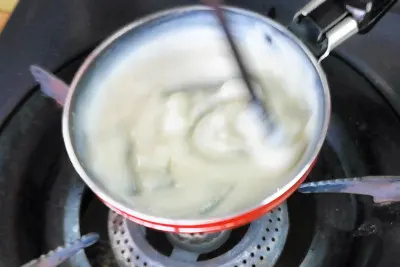
- Dissolve the yeast with 2 tbsps of water, wait for five minutes until the yeast is activated.
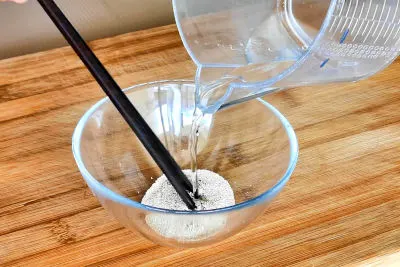
- Mix all the ingredients in (A) and (B) except the butter with the electric mixer (use a dough hook) until it becomes anelastic mass.
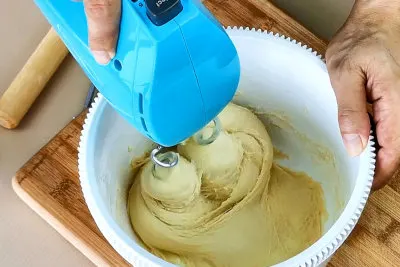
- Add the butter, continue mixing until the butter is thoroughly absorbed.
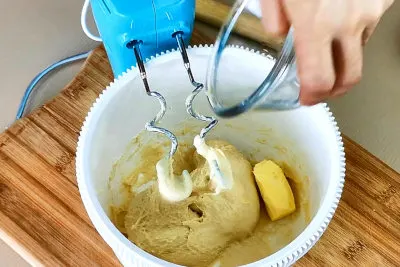
- Cover, let it ferment for 40 minutes or until it doubled in size.
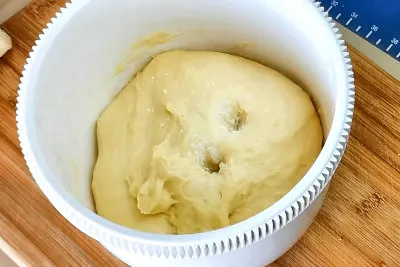
- Punch down the dough. Divide it into 8 pieces.
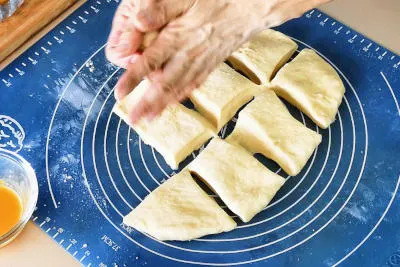
- Shape each portion into smooth, round balls. Let the dough rest for ten minutes. Roll out the dough to form a long robe, about 3.5 to 4 times the length of the sausage.
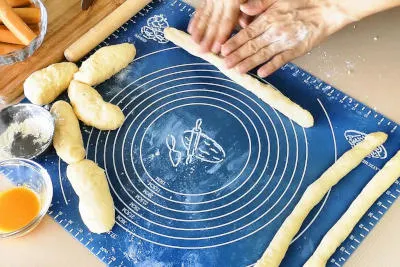
- Blanch the sausage in boiling water for 30 seconds, drained and dried.

- Looped the dough rope around the sausage. Tuck in both ends under the sausage.
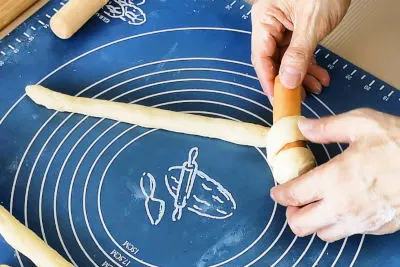
- Cover it with a damp cloth and let it proof for 20 minutes. Apply some egg wash on the surface.
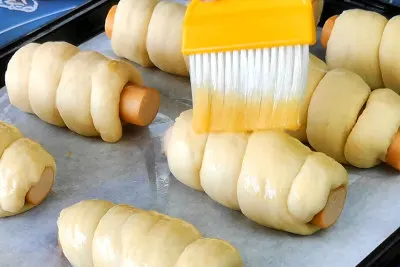
- Bake at 190°C/375°F for 20 minutes or until the crust turns golden brown.

- Remove from the oven. Apply some butter on the surface to have a shining finishing. Serve.

Recommended Products
As an Amazon Associate and member of other affiliate programs, I earn from qualifying purchases.
-
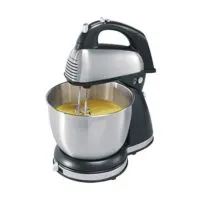 Hamilton Beach 64650 6-Speed Classic Stand Mixer, Stainless Steel, 4-Quart Bowl and Accessories
Hamilton Beach 64650 6-Speed Classic Stand Mixer, Stainless Steel, 4-Quart Bowl and Accessories -
 Red Star GlutenFree Active Dry Yeast, 0.75 oz, 3 ct, 3 pk
Red Star GlutenFree Active Dry Yeast, 0.75 oz, 3 ct, 3 pk -
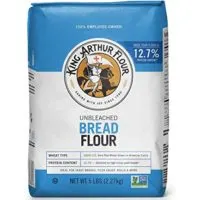 King Arthur Flour Unbleached Bread Flour, 5 Pound (Packaging May Vary)
King Arthur Flour Unbleached Bread Flour, 5 Pound (Packaging May Vary) -
 Stainless Steel Mixing Bowls by Finedine (Set of 6) Polished Mirror Finish Nesting Bowl, ¾ - 1.5-3 - 4-5 - 8 Quart - Cooking Supplies
Stainless Steel Mixing Bowls by Finedine (Set of 6) Polished Mirror Finish Nesting Bowl, ¾ - 1.5-3 - 4-5 - 8 Quart - Cooking Supplies
Nutrition Information:
Yield: 8 Serving Size: 1Amount Per Serving: Calories: 451Total Fat: 27gSaturated Fat: 10gTrans Fat: 0gUnsaturated Fat: 13gCholesterol: 103mgSodium: 755mgCarbohydrates: 37gFiber: 1gSugar: 10gProtein: 15g
This data was provided and calculated by Nutritionix on 4/13/2020

Onyinye
Wednesday 3rd of March 2021
Hello KP, can this recipe be baked as a regular white bread in a loaf pan. Without the sausages. Thanks
KP Kwan
Wednesday 3rd of March 2021
It is Ok to use a loaf pan without the sausages.
Onyinye
Wednesday 3rd of March 2021
Thanks for this recipe. But your write up is quite confusing. In the video you added 2 tbsp of water to the yeast. In the pictorial recipe the 2 tbsp of water is included In the written recipe the 2 tbsp of water is not even written. In your YouTube video recipe card it says 1 tbsp of water. This mix up is quite confusing and almost made me waste my ingredients as my dough was too light. My liquids were: 65ml for the roux, 75ml of milk, 2 tbsp of water which is about 30ml and my egg which should be about 33ml. This made the dough light and I added extra flour. The dough was difficult to work with as it was difficult to get a proper shape. The taste was amazing and the texture very fluffy. This is the best yeast bread recipe I have tried. Pls kindly correct the stated mixup . Thanks from Nigeria.
KP Kwan
Wednesday 3rd of March 2021
Thank you for pointing out the confusion. I have standardized it as 2 tbsp of water.
Dr Ramanathan Gnanasekaran
Sunday 11th of October 2020
Hi ! Love the recipe. Doing it not as I type. One question , do I switch on the fan in the oven ?
KP Kwan
Monday 12th of October 2020
I did not switch on the fan when I baked it. I think you don't need the fan.
Chris
Saturday 16th of May 2020
Hi, how long roughly is the mixing with the dough mixer before adding butter? U mentioned mixing about 10min after add in butter. Before that the mixing?
KP Kwan
Saturday 16th of May 2020
Hi Chris.
Before adding the butter, mix the dough until it becomes an elastic ball. You can test it by lifting the dough hook, and the dough should stretch out like a rubber band. If you stretch the dough with your hand, it will form a thin layer, almost transparent, and not breaking. This may take 6 to 10 minutes, counting from the very beginning. After that, it is time to add the butter. Just enough to mix until all the butter is absorbed. It can be a few minutes.
KP Kwan
Zyu Wenn
Tuesday 12th of May 2020
Hello sifu kwan, thank you for sharing your recipe. I have tried out the paus recipe and it turn out to be lovely.
Tried making these too few days back. But i have some questions. Everything looks the same as ur video until after adding the butter, my dough became super sticky even after being in the mixer for about 10mins low speed. I cant seem to get it to form a ball and a clean surface. I tried removing it and handknead, it all turns out to be a gooey mess. Just wondering is this how the texture suppose to be and just let it proceed to fermentation? Or im suppose add in flour to knead and knead until it forms a firm smooth ball? I saw some other blogs mentioned so.
However, i proceed with baking them and the buns turn out abit hard on the edge and dry. What could possibly be wrong? Could you kindly advice? Thank you.
KP Kwan
Wednesday 13th of May 2020
Hi Zyu Wenn, I think the same situation happens in your comment in Japanese milk bread. Just rescue the amount of water in the recipe. I highly recommend you use a digital weighing machine, just in case you do not have one. That will eliminate the guessing work, whether it is due to the measurement when things are not going your way. Add the butter only after the dough is nearly done that is in the last 2 to 3 minutes. Addition mixing after adding the butter will not make it to form a ball, because the oil in the butter prevents further formation of gluten. Also, please use the dough hook, the attachment for making the cake will ruin the bread texture. Thanks, KP Kwan